Effects of He+ and H+ Co-Implantation with High Energy on Blisters and Craters of Si and SiO2-On-Si Wafers
Abstract
1. Introduction
2. Materials and Methods
3. Experiment Results
4. Discussion
5. Conclusions
Author Contributions
Funding
Acknowledgments
Conflicts of Interest
References
- Liu, C.L.; Li, M.K.; Wang, Z.; Gao, Y.J.; Liao, J.Q.; Zhang, D.C.; Zhang, X.L.; Shen, Y.Y. Correlation between surface damage and micro-defects in Si covered with insulating layer by implantation of He and H ions. Thin Solid Films 2011, 519, 3162–3168. [Google Scholar] [CrossRef]
- Daghbouj, N.; Cherkashin, N.; Claverie, A. A method to determine the pressure and densities of gas stored in blisters: Application to H and He sequential ion implantation in silicon. Microelectron. Eng. 2018, 190, 54–56. [Google Scholar] [CrossRef]
- Bruel, M. Silicon on insulator material technology. Electron. Lett. 1995, 31, 1201–1202. [Google Scholar] [CrossRef]
- Grisolia, J.; Ben Assayag, G.; Claverie, A.; Aspar, B.; Lagahe, C.; Laanab, L. A transmission electron microscopy quantitative study of the growth kinetics of H platelets in Si. Appl. Phys. Lett. 2000, 76, 852–854. [Google Scholar] [CrossRef]
- Personnic, S.; Bourdelle, K.K.; Letertre, F.; Tauzin, A.; Cherkashin, N.; Claverie, A.; Fortunier, R.; Klocker, H. Impact of the transient formation of molecular hydrogen on the microcrack nucleation and evolution in H-implanted Si. J. Appl. Phys. 2008, 103, 023508. [Google Scholar] [CrossRef]
- Van Den Bos, R.A.J.M.; Reshetniak, V.; Lee, C.J.; Benschop, J.; Bijkerk, F. A model for pressurized hydrogen induced thin film blisters. J. Appl. Phys. 2016, 120, 235304. [Google Scholar] [CrossRef]
- Liu, C.; Wang, Z.; Li, M.; Li, W.; Yuan, B.; Wu, P.; Liu, T. Effects of the oxide layer on cavity formation and He desorption in He implanted silicon. J. Phys. D Appl. Phys. 2008, 41, 135108. [Google Scholar] [CrossRef]
- Cherkashin, N.; Daghbouj, N.; Darras, F.X.; Fnaiech, M.; Claverie, A. Cracks and blisters formed close to a silicon wafer surface by He-H co-implantation at low energy. J. Appl. Phys. 2015, 118, 245301. [Google Scholar] [CrossRef]
- Moutanabbir, O.; Terreault, B.; Chicoine, M.; Schiettekatte, F. The fluence effect in hydrogen-ion cleaving of silicon at the sub-100-nm scale. Appl. Phys. A Mater. Sci. Process. 2005, 80, 1455–1462. [Google Scholar] [CrossRef]
- Daghbouj, N.; Li, B.S.; Callisti, M.; Sen, H.S.; Karlik, M.; Polcar, T. Microstructural evolution of helium-irradiated 6H–SiC subjected to different irradiation conditions and annealing temperatures: A multiple characterization study. Acta Mater. 2019, 181, 160–172. [Google Scholar] [CrossRef]
- Agarwal, A.; Haynes, T.E.; Venezia, V.C.; Eaglesham, D.J.; Weldon, M.K.; Chabal, Y.J.; Holland, O.W. Efficient production of silicon-on-insulator films by co-implantation of He+ with H+. IEEE Int. SOI Conf. 1997, 1086, 44–45. [Google Scholar]
- Hebras, X.; Nguyen, P.; Bourdelle, K.K.; Letertre, F.; Cherkashin, N.; Claverie, A. Comparison of platelet formation in hydrogen and helium-implanted silicon. Nucl. Instrum. Methods Phys. Res. Sect. B Beam Interact. Mater. Atoms 2007, 262, 24–28. [Google Scholar] [CrossRef]
- Daghbouj, N.; Cherkashin, N.; Darras, F.X.; Paillard, V.; Fnaiech, M.; Claverie, A. Effect of the order of He+ and H+ ion co-implantation on damage generation and thermal evolution of complexes, platelets, and blisters in silicon. J. Appl. Phys. 2016, 119, 135308. [Google Scholar] [CrossRef]
- Cherkashin, N.; Daghbouj, N.; Seine, G.; Claverie, A. Impact of He and H relative depth distributions on the result of sequential He+ and H+ ion implantation and annealing in silicon. J. Appl. Phys. 2018, 123, 161556. [Google Scholar] [CrossRef]
- Biersack, J.P.; Ziegler, J.F. The Stopping and Range of Ions in Solids. In Ion Implantation Techniques; Springer: Berlin/Heidelberg, Germany, 1985; pp. 122–156. [Google Scholar]
- Li, M.; Wang, Z.; Liu, C.; Liao, J.; Shen, Y.; Zhang, L.; Yuan, B. Two layer surface exfoliation on Si3N4/Si by sequential implantation of He and H ions. J. Electron. Mater. 2009, 38, 1990–1994. [Google Scholar] [CrossRef]
- Chabal, Y.J.; Weldon, M.K.; Caudano, Y.; Stefanov, B.B.; Raghavachari, K. Spectroscopic studies of H-decorated interstitials and vacancies in thin-film silicon exfoliation. Phys. B Condens. Matter 1999, 273, 152–163. [Google Scholar] [CrossRef]
- Liang, J.H.; Hsieh, H.Y.; Wu, C.W.; Lin, C.M. Dependence of implantation sequence on surface blistering characteristics due to H and He ions co-implanted in silicon. Nucl. Instrum. Methods Phys. Res. Sect. B Beam Interact. Mater. Atoms 2015, 365, 128–132. [Google Scholar] [CrossRef]
- Moutanabbir, O.; Terreault, B. Effects in synergistic blistering of silicon by coimplantation of H, D, and He ions. Appl. Phys. Lett. 2005, 86, 1–3. [Google Scholar] [CrossRef]
- Miao, D.; Wu, S.; Dai, X.; Zhao, T.; Hao, Y. The formation mechanism of globally biaxial strain in He+ implanted silicon-on-insulator wafer based on the plastic deformation and smooth sliding of buried SiO2 film. Appl. Phys. Lett. 2018, 113, 221602. [Google Scholar] [CrossRef]
- Moutanabbir, O.; Terreault, B. Raman-scattering elucidation of the giant Isotope effect in hydrogen-Ion blistering of silicon. J. Chem. Phys. 2004, 121, 7973–7986. [Google Scholar] [CrossRef]
- Daghbouj, N.; Li, B.S.; Karlik, M.; Declemy, A. 6H-SiC blistering efficiency as a function of the hydrogen implantation fluence. Appl. Surf. Sci. 2019, 466, 141–150. [Google Scholar] [CrossRef]
- Reboh, S.; De Mattos, A.A.D.; Schaurich, F.; Fichtner, P.F.P.; Beaufort, M.F.; Barbot, J.F. The mechanisms of surface exfoliation in H and He implanted Si crystals. Scr. Mater. 2011, 65, 1045–1048. [Google Scholar] [CrossRef]
- Mitani, K.; Gösele, U.M. Formation of interface bubbles in bonded silicon wafers: A thermodynamic model. Appl. Phys. A Solids Surf. 1992, 54, 543–552. [Google Scholar] [CrossRef]
- Alatalo, M.; Puska, M.J.; Nieminen, R.M. First-principles study of He in Si. Phys. Rev. B 1992, 46, 12806–12809. [Google Scholar] [CrossRef] [PubMed]
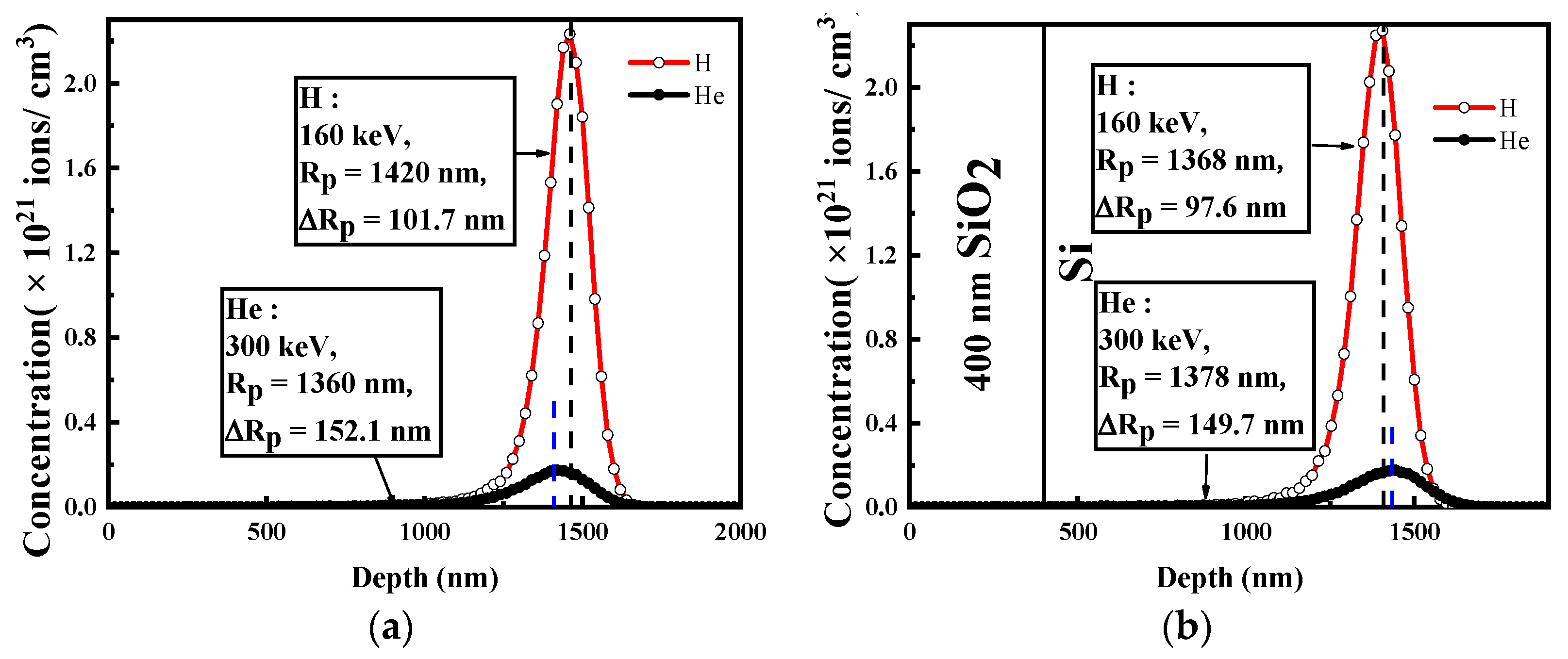

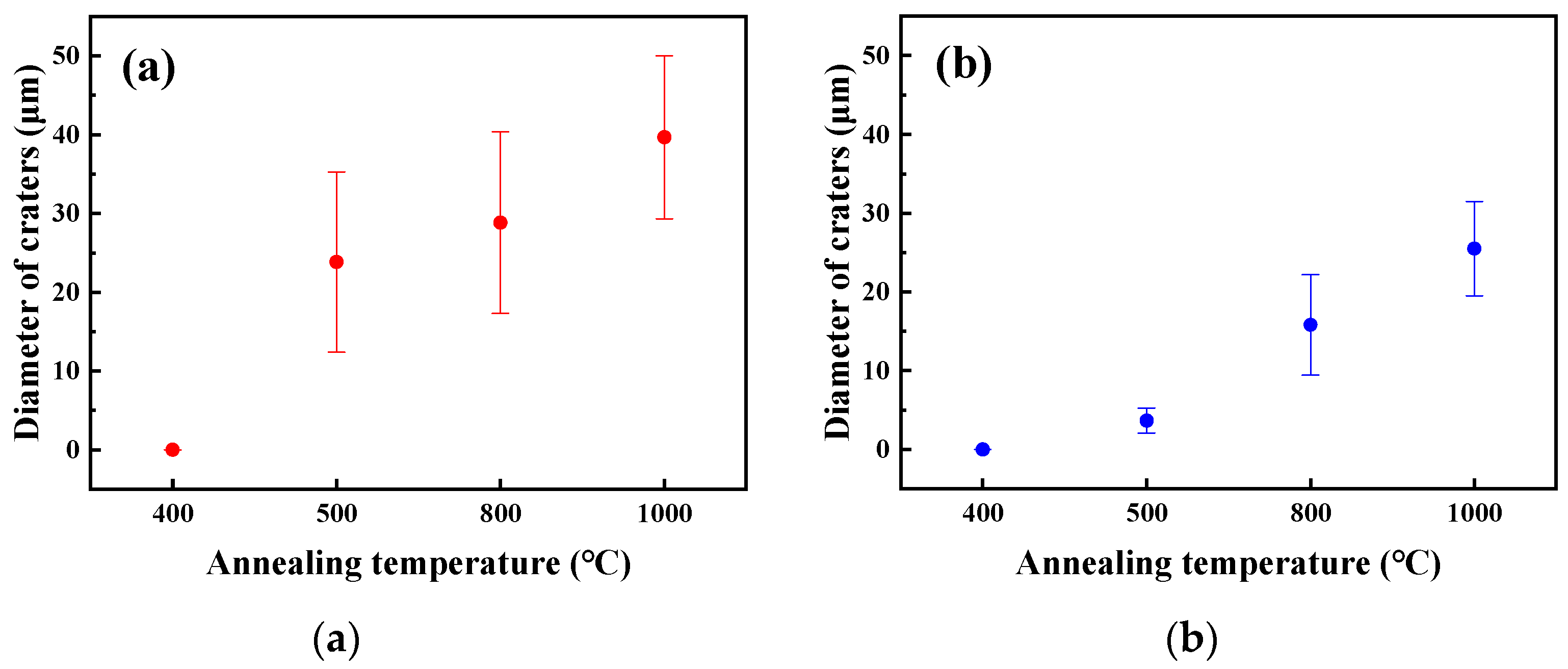
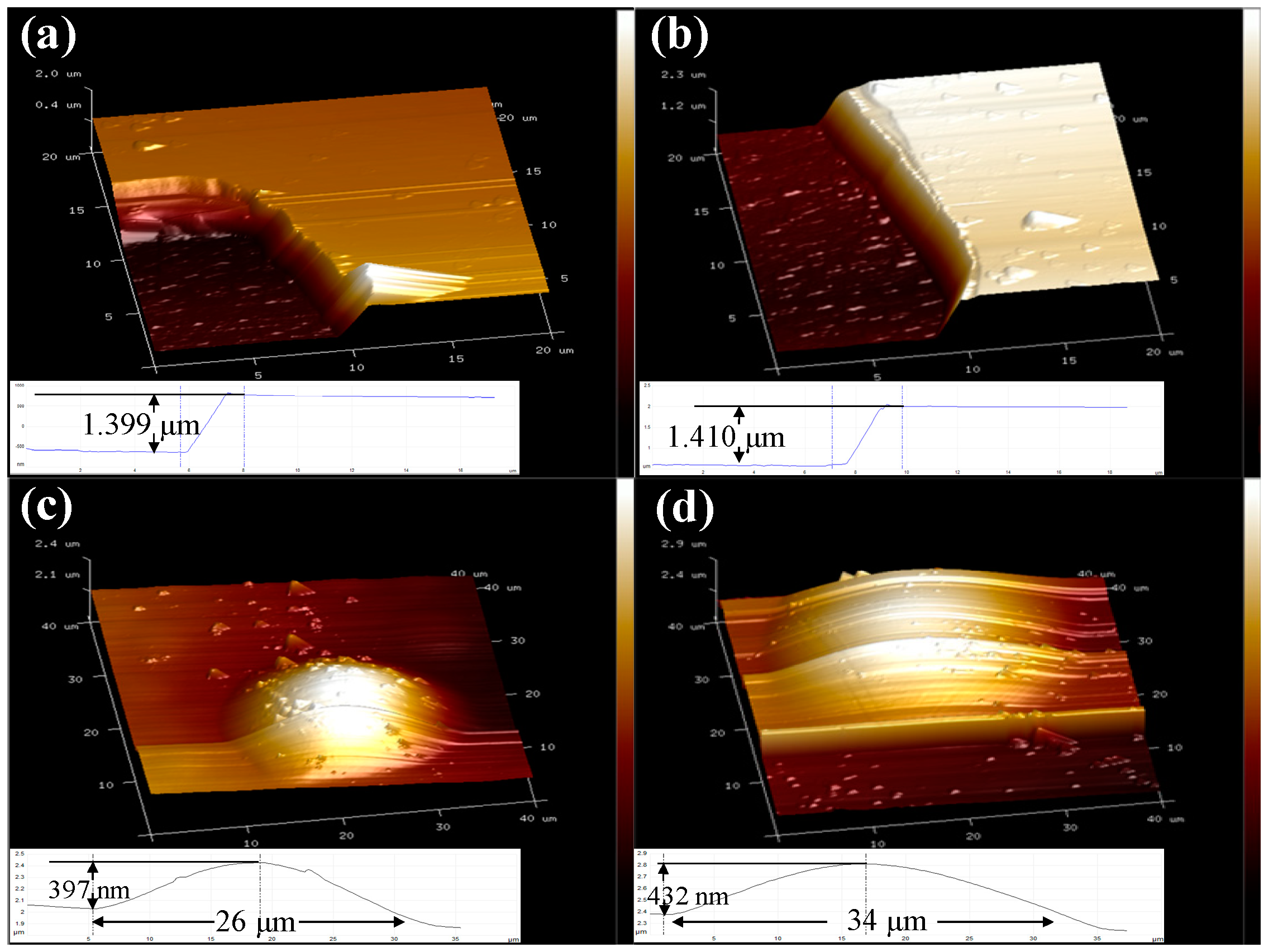
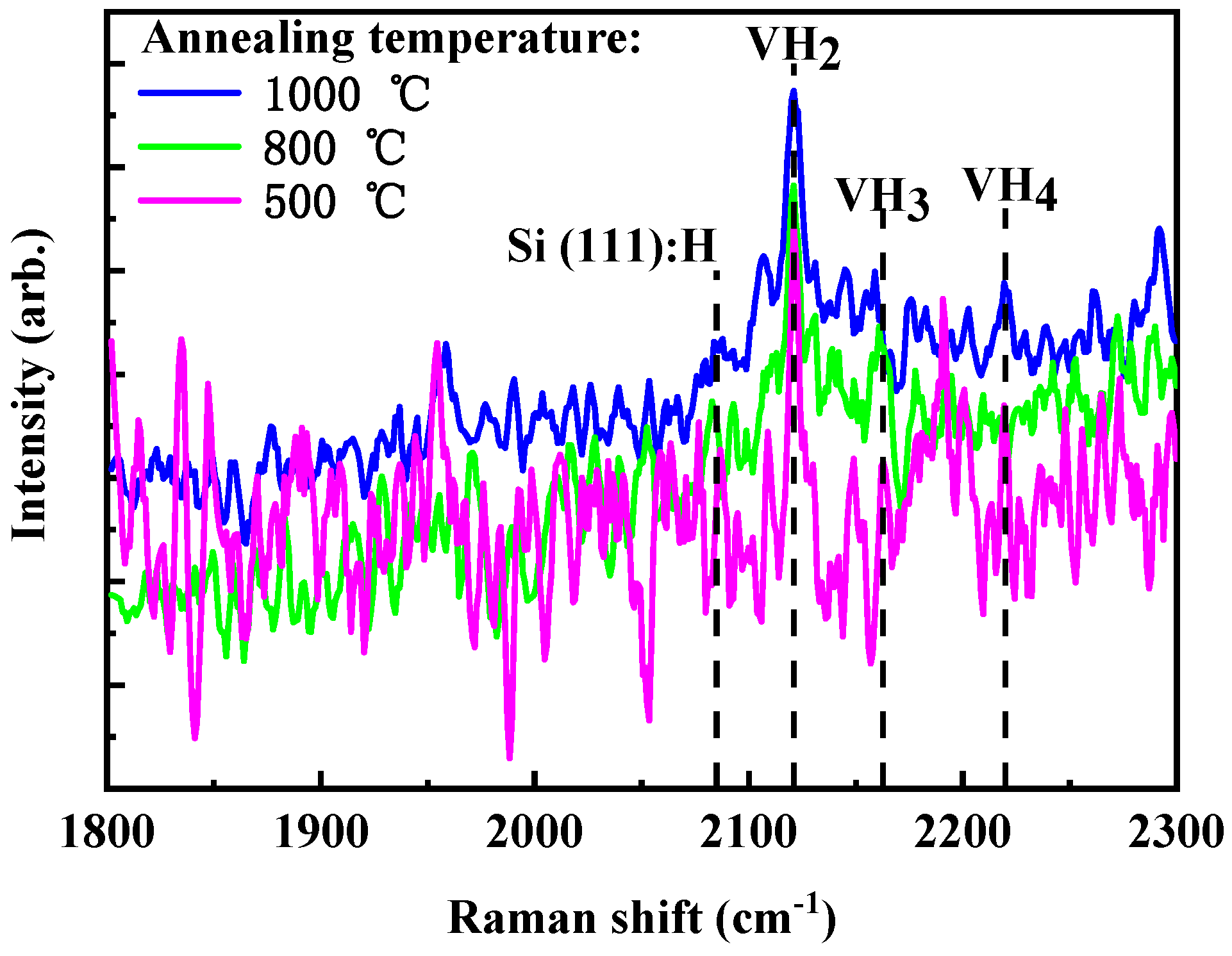
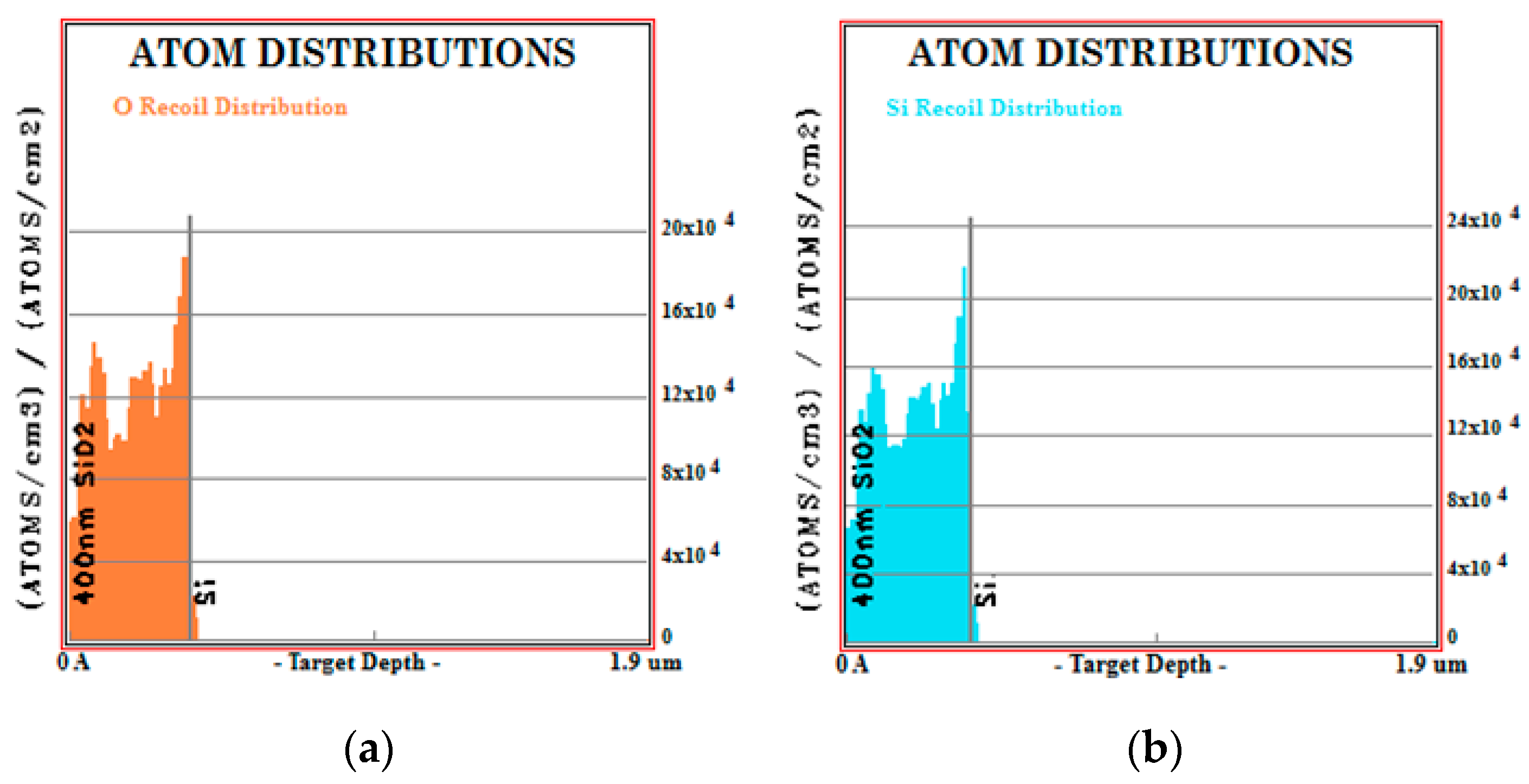
| Sample No. | Materials | He+ Dose (1016 /cm2) | H+ Dose (1016 /cm2) | He+ Implantation Energy (keV) | H+ Implantation Energy (keV) |
|---|---|---|---|---|---|
| A | Si | 5 | — | 300 | — |
| B | Si | 0.5 | 4 | 300 | 160 |
| C | SiO2-on-Si | 0.5 | 4 | 300 | 160 |
© 2019 by the authors. Licensee MDPI, Basel, Switzerland. This article is an open access article distributed under the terms and conditions of the Creative Commons Attribution (CC BY) license (http://creativecommons.org/licenses/by/4.0/).
Share and Cite
Huang, R.; Lan, T.; Li, C.; Li, J.; Wang, Z. Effects of He+ and H+ Co-Implantation with High Energy on Blisters and Craters of Si and SiO2-On-Si Wafers. Crystals 2019, 9, 671. https://doi.org/10.3390/cryst9120671
Huang R, Lan T, Li C, Li J, Wang Z. Effects of He+ and H+ Co-Implantation with High Energy on Blisters and Craters of Si and SiO2-On-Si Wafers. Crystals. 2019; 9(12):671. https://doi.org/10.3390/cryst9120671
Chicago/Turabian StyleHuang, Rui, Tian Lan, Chong Li, Jing Li, and Zhiyong Wang. 2019. "Effects of He+ and H+ Co-Implantation with High Energy on Blisters and Craters of Si and SiO2-On-Si Wafers" Crystals 9, no. 12: 671. https://doi.org/10.3390/cryst9120671
APA StyleHuang, R., Lan, T., Li, C., Li, J., & Wang, Z. (2019). Effects of He+ and H+ Co-Implantation with High Energy on Blisters and Craters of Si and SiO2-On-Si Wafers. Crystals, 9(12), 671. https://doi.org/10.3390/cryst9120671





